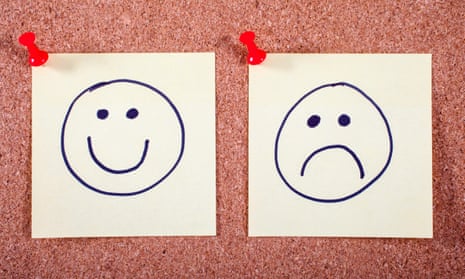“When you are high, it is tremendous. Shyness goes, the right words and gestures are suddenly there, the power to seduce and captivate others a felt certainty. Feelings of ease, intensity, power, well-being, financial omnipotence and euphoria now pervade one’s marrow. But somehow, this changes. The fast ideas are far too fast and there are far too many, overwhelming confusion replaced by fear and concern. You are irritable, angry, frightened, uncontrollable, and enmeshed totally in the blackest caves of mind … It goes on and on and finally there are only other people’s recollections of your behaviour – your bizarre, frenetic, aimless behaviour …” – A patient’s account in Manic-Depressive Illness by FK Goodwin and KR Jamison
To be creative, energetic and gregarious – these are the things to which many of us aspire. Although some are lucky enough to display them naturally, the majority of us have to work to develop them as best we can. But what if your episodes of productivity, creativity and energy signify an episode of mental ill-health? For many people with bipolar disorder, this is precisely the case. Formerly referred to as “manic depression”, bipolar disorder is characterised by fluctuations in mood. Episodes of depression – often marked by sadness, lethargy and hopelessness – can be followed by periods of elation.
In the early stages, this elation is termed “hypomania”, and this is often when a person is at their most inventive and sociable. If hypomania develops further, the person may be considered to be in the midst of a “manic” episode. While sharp elevations in mood may sound appealing in principle, the reality is that mania can be associated with a range of impulsive behaviours, including substance use, promiscuity and excessive spending, all of which can have severe adverse consequences. It can be an exceptionally high price to pay for a relatively short spell of confidence and ingenuity.
Although bipolar disorder – referring to the twin “poles” of depression and mania – is cyclical, it’s not necessarily the case that it results in continuously fluctuating moods; nor does everyone with the diagnosis experience oscillations of similar severity. Some people will experience mild elation but severe depressions; others will report hypomania and only mild depression. As with many mental health problems, two people with a similar diagnosis can exhibit very different symptoms. Approximately 1-3% of people will display symptoms indicative of bipolar disorder at some point in their lives, but many also present with other emotional difficulties, most notably anxiety disorders.
As with many mental health problems, we’re not sure exactly what causes bipolar disorder, although there is some evidence that having a parent with the condition increases your risk of developing it by a factor of eight (although the children of people with bipolar are actually more likely to develop unipolar depression, without episodes of mania). This suggests that, the possibility of inherited predisposition aside, the most significant risk factor for developing bipolar may be environmental stress. It’s hardly surprising, of course – we know that stressful life events, particularly those experienced in childhood, are associated with significantly higher rates of anxiety, depression, post-traumatic stress disorder and schizophrenia. But, again, these are associations only – a substantial number of people experience multiple adverse life events, but not all will go on to be diagnosed with a severe and enduring mental illness. What appears critical is the way individuals cope with that adversity, and, interestingly, we might have rather less control over that than we like to think.
We know that optimal wellbeing is dependent on a number of factors, one of the most important of which is the amount of social support we have. Put simply, the better the quality of your relationships, the more likely you are to be able to manage stressful situations. The association becomes even more marked as the severity of the stress increases.
This support will look different at different life stages, of course – the social network you are likely to have aged 10 is likely to bear little relationship to the network you have in middle age. But what if it is the people in that network – the people who should provide support – who are actually the cause of, or implicated in, your distress? If you come from a family in which violence is perpetrated, you may not learn that relationships can be safe and comforting, and, in that case, you could hardly be blamed for avoiding them later in life. Equally, if you have a diagnosis of a serious mental illness, it’s likely that you’ll find it much harder to maintain employment and to form intimate relationships.
Given all that, it’s perhaps unsurprising that people experiencing seemingly uncontrollable fluctuations in mood (and who may also be dealing with the after-effects of trauma and other adversity) might choose to try to regulate their emotions in any way they can – not infrequently with drugs or alcohol. And while these may be helpful in reducing the variations at that point, it’s rarely sustainable, or without negative consequences.
Most people who have a diagnosis of bipolar and who are in contact with mental health services will be prescribed medication. While some will take antidepressants and/or antipsychotics – to reduce the effects of the lows and the highs respectively – many are prescribed mood stabilisers such as lithium or sodium valproate, and though the research shows effectiveness, they may cause some side-effects. Overexposure to lithium, for example, can affect renal function.
Psychological therapy has also been shown to augment pharmacological treatments and may be effective in helping people to reduce variations in mood, and to understand the triggers that can precipitate both depression and mania. Practically, this is often about monitoring your mood and reducing stress, or finding ways to cope with that stress more effectively. Cognitive therapy may also help to build people’s confidence in managing their symptoms by challenging thoughts such as, “I have no control over how I feel.” Most therapies will ask that you complete “homework” between sessions, partly to practise the techniques discussed with your therapist and partly so their usefulness in “real life” can be evaluated.
The difficulties associated with bipolar disorder will rarely affect only the person with the diagnosis, however: there is virtually always an impact on family members. While it doesn’t target the symptoms directly, family therapy has been shown to be effective in helping to diminish bipolar-related symptoms and to reduce the risk of relapse.
In short, a diagnosis of bipolar means much more than periodic “highs”, and, despite the perceived benefits of a slightly elevated mood, very few of the people I have come across with the diagnosis see it so positively. It is far from “untreatable”, but the road to full functioning – if it can ever be achieved – is likely to be a difficult one.

